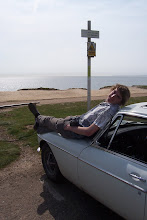Due to her competition history, I think it would be flipping rude not to get her back out taking on other inferior motor vehicles. So I am rebuilding her for road and Historic Endurance rallying. No huge changes really, and nothing which cannot be undone or removed easily, as I am fed up with the amount of hacked around classics which have been modified for the sake of being modified.
So the alterations are subtle, based on ironing out any chances of breakdown or failure, based on common vehicle breakdown causes, research into MGB weak areas both in normal use and in competition, and making the car slightly more responsive and giving it the ability to use rough roads without problems.
All of which had to be done in such a was as to:
-Make no alterations to the standard vehicle which could not quickly and easily be undone or removed, so I could return her to dead standard in a few hours.
-Make the overall appearance and design of the car, and any extras, look like a period amateur rally car of the day. So only additions which could have, and would have, been made and fitted to an MGB owner in his workshop to give his car a better chance at rallying. Using materials, equipment and methods of the early 1970s and before.
-Still be useable every day. That involves driving everywhere, town use, a lot of night driving and speed bumps. No alterations could compromise the usability of the car on the road.
-Protect the car from sustaining damage which would render it unusable. Most clubman’s rally cars we used daily, like mine. Taking the exhaust off on a rock, then not being able to drive the next day is not a good situation.
-Make the car legal and eligible for use in rallying. Anything which contravenes regulations would need to be removable or attachable quickly and easily.
So a big list was made, items were considered, debated upon, researched and decided upon. The current list of rallying tweaks, which either have been or will be undertaken, are below.
-Strengthened and seam welded body shell, with adequate protection for wet, muddy and rough road use… this is what I have been making so far! As well as spot welds in the original places, much seam welding has been done in the areas required to give the bodyshell more strength without affecting the corner-to-corner flexibility required for good handling on bad roads. The underside is more than adequately protected, and as the topside is painted in cellulose, stone chips and hedge scratches can be easily repaired.
-Driving lamps fitted to the front, with fog and spot lenses. An additional auxiliary wiring loom will supply power, and a bolt on alloy plate in the engine bay will hold the relays and fusebox for the lamps.
-Higher powered reversing lamps, utilising the original mounting holes.
-SU double ended fuel pumps- two of these will be fitted, with each pump being individually switched.
-Wiring loom to has all connections soldered, all lengths of loom at risk of abrasion damage will be reinforced. Sidelight clusters will have separate earths, and dipped and main beam headlamps will be wired through relays.
-Potti map magnifier fitted
-Fire extinguishers
-Navigator’s footrest
-All other navigational equipment and aux switching will be mounted on an alloy panel on the dashboard. This will hold the map reading lamp, stopclocks and their lights, pacenote lamps, trip computer, and switching for aux lamps, fuel pumps, navigational equipment and the navigator’s horn button.
-Accelerator pedal extension for the old heel and toe
-Leather bonnet straps to keep bonnet on
-Copper brake pipes, for corrosion resistance
-Battery cut-out switch mounted within reach of driver
-Single 12v high capacity battery, in one of the original battery boxes-Exhaust system mounted higher to reduce risk of damage.
-Decent heat reflecting material applied to underside of heat shield, to prevent fuel vaporisation-Fuel filter & pressure regulator, to tame the SU double-banger pumps, and filter out the fuel efficiently.
-Spare coil mounted above first
-In addition, a spare distributor will always be carried, rebuild and working, in case of any ignition problem it can be fitted in minutes far more easily than points or condenser.
-Sump guard
-Higher output alternator
-Waterproofed distributor, and all grommets and holes into the bodyshell sealed effectively.
-Intake manifold core plugs fitted with straps to prevent them coming adrift.
-Polyurethane suspension bushes, the closest colour to black as possible.
-Uprated dampers
-Slightly stiffer front springs
-Possibly a thicker anti-roll bar
So there we go, all this needs to be incorporated. It will hopefully be a capable and reliable machine once finished…
Thursday, 26 November 2009
Subscribe to:
Post Comments (Atom)

No comments:
Post a Comment